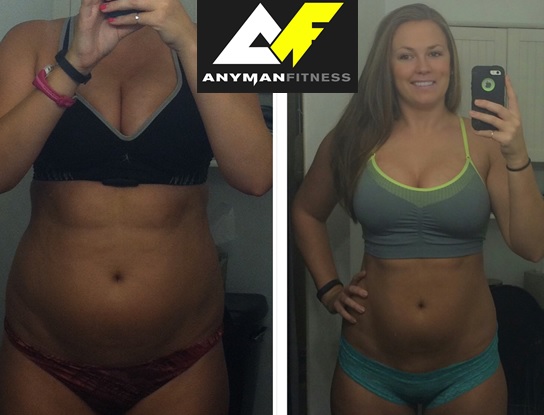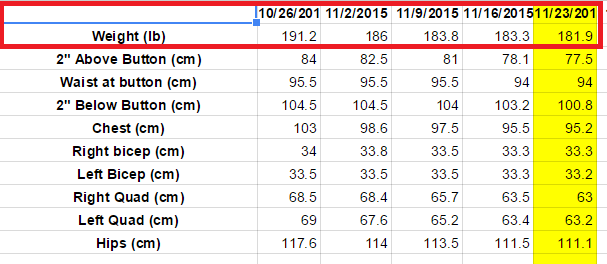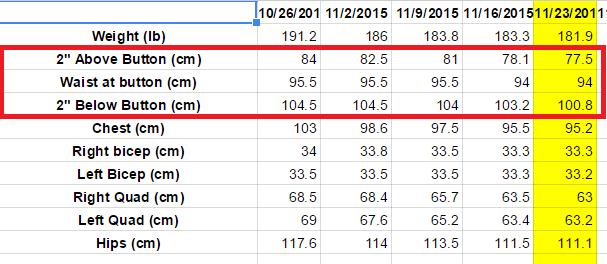You should despise your bathroom scale.
Your bathroom scale holds so much power over you.
Every time you weigh yourself, you wait for those digital numbers to show you your current progress.
You tap your toe on the middle of the scale and wait for the scale to “wake up” and show you those “double zeroes”.
You climb atop the scale with both feet, cautiously attempting to stand perfectly still without shifting your weight left or right.
You close your eyes, cross your fingers, and wince, pleading for a number which will satisfy you.
You’ve been good, after all. You haven’t missed a workout, you’ve been rather hungry, and you’ve tried to emphasize protein and veggies.
You should be rewarded. Right?
You’ve been good to your body. If the scale returns the favor and shows you a respectable number, your day will be a success. You’ll be happy, you’ll be energized, you’ll be in a good mood, and you’ll gladly eat your whole foods lunch and hit up the gym after work.
But if it doesn’t?
Then what?
How many diets have been derailed when a sub-par scale reading puts someone in a bad mood?
What are we training and eating right for, if we are not going to be rewarded?
What if there was a better way to gauge progress?
What if I told you that when the numbers DON’T read like you want them to, there’s an EXCELLENT chance you are still losing fat quickly and effectively.
What if your scale was the biggest problem standing in between you and your goals?
Guess The Fat Loss
Take a close look at online client Maggie.
How much fat do you think Maggie has lost from B to D?
If Maggie were only checking the scale, she would assume she has lost 11 pounds of fat. This is the difference in bodyweight between pictures B and D.
This is all the scale will see.
An 11 pound loss of fat is solid, but this is a long-term progress picture. If you were Maggie, you may look at that 11 pounds and be disappointed or indifferent.
Luckily, Maggie has been working with us and we have her on different parameters.
We’ll discuss the answer later in this article. But spoiler alert: Maggie lost more than a paltry 11 pounds.
Her scale wouldn’t tell her what really happened, though.
We made sure to fill her in.
The body fat analysis she had done confirmed our estimations.
The Limitations Of The Scale
The scale does one thing, exactly: It measures your gravitational pull on the earth for one instant in time.
The scale doesn’t measure fat loss effectively at all.
Some items the scale doesn’t pick up:
- Muscular gain.
- This is especially important when a beginner is lifting weights. Lean body mass (muscle) is more dense than fat, meaning a small amount of it will weigh more than fat does.
- Water retention.
- Water retention can be due to many factors. Food selections, hydration levels, menstrual cycles, carbohydrate consumption, sedentary situations such as travel, etc.
- Each gram of carbohydrates eaten adds 4 grams of water to your bodyweight. It takes time for this water to pass through you. If you eat your daily maintenance in just carbs for one day, you will not gain fat. You will gain scale weight which will take a few days to settle back down.
- Bowel contents.
- Getting adequate fiber – or supplementing your intake – can help reduce this number, but we all have fecal matter inside of us. The difference pre-bowel movement and post-bowel movement can be substantial.
- Stomach content.
- The digestive process takes time. If you normally eat dinner at 5 pm, and instead you decide to have a late dinner at 8 pm, this will affect your weight in the morning.
- When dieting, you naturally have less stomach content than you do during maintenance/bulking situations.
- Cellular glycogen.
- Your body holds onto sugar at the cellular level. When you deplete your body of its fuel, it will tap into this stored glycogen to give you energy. When you are in a calorie deficit, you will weigh less as a result of having less glycogen in your cells.
- Hormonal fluctuations.
- Natural cycles, most often seen in women during their menstrual cycles, can wreak havoc on the scale.
- This can also be seen in males during times of duress and/or stress. Changes in job responsibility, tense situations at home, lack of sleep due to young children, etc. can elevate cortisol levels, which in turn, can effect your scale weight.
.
The scale does have its usefulness, however. Over time, you will likely see a drop in scale weight as you train and eat well.
For many, this usefulness will not trump the anxiety and stress it will cause them.
When it is obvious one of our clients is stressed out with the scale, we tell the client to throw it away completely.
Kari fell into this category. She was living and dying by the daily fluctuations in the scale. It took some time and unraveling before she realized the harm she was doing to herself. After she got into the proper, habit building mindset, and put her scale in the closet, the inches began coming off steadily.
Look at her progress, after the scale was ignored:
Although we didn’t take scale weight with Kari, we did use data in order to guide and inform our decisions.
Here is an inside look at what we do with clients.
Feel free to use our parameters in your own routines to gauge your progress.
Client Checkpoint Parameters
We utilize rigid checkpoint parameters with online clients.
Our checkpoints are on Monday mornings.
In order to correctly gauge what is happening, we must have completely accurate data.
No “close-enoughs” or missed data points. 100% accuracy within the given constraints.
Which are:
- Data is taken once per week, on the same day, in the morning, after using the restroom and before eating or drinking anything.
- Data is taken from 9 different areas.
- Waist circumference 2 inches above the belly button, with abdominals flexed.
- Waist circumference at belly button, with abdominals flexed.
- Waist circumference 2 inches below the belly button, with abdominals flexed.
- Hip circumference at the lowest comfortable point.
- Right bicep circumference, flexed, at the largest point.
- Left bicep circumference, flexed, at the largest point.
- Right quadricep (thigh) circumference, flexed, at the largest point.
- Left quadricep circumference, flexed, at the largest point.
- Chest circumference.
- For males, this means at the nipples, flexed.
- For females, this means under the armpits.
- Scale weight. (Yes, we do take scale weight. Please notice its importance.)
- Measurements are taken in centimeters only with accuracy to the tenth of a centimeter, no exceptions. This can take some getting used to for American clients. Once it is practiced a bit, the accuracy is far superior than inches.
- An OrbiTape or MyoTape are your best friends – a cloth tape measure will work, but can be tricky.
How To Analyze Your Data
Let the fun begin… data analysis.
When you begin on a new regimen, be sure to take your baseline data using these parameters as well. No need to binge yourself silly and take your data after your gluttonous activities.
Most will find they will “woosh” at the start.
This is due to decreased carbohydrate consumption, stomach content, cellular glycogen, etc.
You will also likely be eating better foods, getting more fiber, and training harder and/or more frequently than you are used to.
Here are an example of a “weight woosh” at the start of a diet, and what follows in the weeks to come.
Notice the data in the red box.
This client lost 5.2 pounds in her first WEEK – which would have made her happy as a clam.
As the weeks progress, though, you will see this is not a linear situation.
Week 2 (from 11/2 – 11/9), the client lost 2.2 pounds, less than half of her first week losses.
Week 3 (from 11/9 – 11/16)… nothing… At least nothing according to the scale.
This is a perfect example of a situation where someone would be frustrated if they were not taking body measurements.
Would this be enough to derail a determined individual, causing them to binge?
Let’s look at a few other items in this data.
Take a close look at the red box again.
The waist measurements show a much more reliable view of what is happening to this client.
Each week, there is steady and measurable progress.
Notice how the weight drops and the waist measurement drops do NOT coincide with each other.
From 11/9 – 11/16, there was zero weight loss… and there was a 1.9 centimeter drop 2 inches above the belly button.
From 11/16-11/23, there was no loss on the belly button… but there was a 2.4 centimeter drop 2 inches below the belly button as well as a 1.4 pound weight loss on the scale.
Without taking data from all these different places, you will likely miss something.
We have seen it all.
We have seen clients lose 6 inches off the waistline and have the scale barely move at all.
That happened to Rachel here.
Does this look like someone who has lost zero body fat?
The scale weight is the same for both pictures.
We have also seen the flip side of this.
Sometimes a 6 inch loss on the waistline means a 23 pound loss on the scale.
Susie experienced this:
So, what do we do with this data?
What should we look at?
Here is what we discuss with our online clients when they check in with us:
- Scale weight.
- Yes, we do discuss scale weight first. After all, if the scale weight is going down, everyone is happy. This is natural, so there is no reason to fight it.
- If the scale weight is moving downwards, we continue as planned.
- If the scale weight isn’t moving, then we look at………..
- Waist measurement.
- We look at 4 different spots – 2 inches above/below, the belly, and the hips.
- Fat loss most often shows up in males and females on the waist measurement. This is especially true the more weight you have to lose. If you are already on the leaner side, this potentially not be the case for you.
- With our clients who show linear losses on the waist as well as the scale, an inch off of the waistline means 4-5 pounds of fat loss.
- We use this metric (1 inch off waist = 4-5 pounds of fat loss) with our clients with nearly perfect accuracy when measured via body fat analysis measures.
- If waist measurements are going down, we continue as planned.
- If the waist measurement isn’t moving, then we look at……………
- Other measurements.
- The next most common place to spot fat loss is the chest measurement.
- After the chest measurement, it’s a toss up.
- Some lose in their thighs, others their biceps.
- This is entirely caused by genetics.
- In a perfect world, we could “spot reduce” and pick where the fat loss comes from. But this is reality, and we have to roll with the punches here.
- If the thigh or quad measurements are going down, we continue as planned.
- If the thigh or quad measurements aren’t going down, then we look at……….
- Other factors.
- Is the client sleeping well? How many hours per night? Good rest is crucial to recovery, performance, fat loss, and muscle gain.
- How is the client’s mood? In relation to their normal mood, of course. Happier? Grumpier? Frustrated? Agitated? Cheery?
- How is the client’s compliance? What percent of days was the client on point?
- Is the client hydrated?
- Were there any “cheat meals” or “off meals”?
- If female, where is the client in her menstrual cycle?
- What stresses is the client currently facing at work, at home, or otherwise?
- Were there any missed workouts?
.
If the scale, the waist, the thighs/biceps, and all other factors have been eliminated, and the client still is not making progress, we don’t automatically make an adjustment to the program, either.
The leaner you get, the more you will experience stalls in your fat loss.
There is a theory, popularized by Lyle McDonald in this article, that your fat cells hold onto water, even after they have been eliminated. They then will all “woosh” out of the body at the same time, causing a sudden drop in measurements and scale weight.
With our clients, data must be stagnant (with good compliance) for a solid 2-3 weeks before we start to discuss making a macronutrient or calorie adjustment.
After every 12 weeks, we advise a diet break per these parameters, and once we continue working, we will often make small adjustments to calories to account for the slight loss in body weight.
In 99% of the situations we have encountered, waiting out stalls and wooshes will reward the client nicely – no adjustments are necessary.
Be patient with your fat loss and you will reap the rewards.
What Was Maggie’s Data?
Remember Maggie, from the first paragraph?
Here she is again, in case you forgot:
So, remembering that the scale said 11 pounds of weight loss, how much fat do you think was actually lost?
During Maggie’s time with us, she lost 18 pounds of fat.
The difference between picture B and picture D is 4.5 inches off the waist.
With our metric of 1 inch off the waist = 4 pounds of fat, our guess would have been right on the money, since 4 x 4.5 = 18.
Maggie also gained 7 pounds of muscle as well, for a total scale difference of 11 pounds.
This is an excellent example of a total body recomposition.
If Maggie wasn’t taking measurements, she could have easily missed the amazing progress she had made.
We hope you found this information useful. Using our parameters, you will never again wonder if you’re losing fat.
You will have concrete evidence and you will be armed with enough information to make intelligent decisions from here on out.
Any questions, feel free to ask in the comments section.
-Jason






